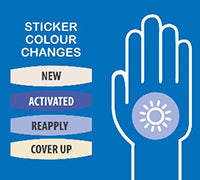Fitting and Disposing
Wristband Fitting Directions

- SECURE Band on wrist with printed side up, leaving enough space to insert 2 fingers between Band and wrist.
- ACTIVATE Band by exposing it to direct sunlight. It will change to dark purple within 3 minutes.
- APPLY sunscreen to the entire Band and allow 15 minutes before getting Band wet.
- REAPPLY sunscreen to your skin and the Band when the Band changes to light purple.
- COVER UP or AVOID of the sun when the Band changes to cream or off white. You have reached your maximum daily UV exposure. Your Band has finished monitoring UV and is not reusable.
IMPORTANT
- This product DOES NOT contain sunscreen and DOES NOT protect against sunburn.
- It is recommended you always use sunscreen, wear protective clothing, a broad brimmed hat and sunglasses when out in the sun and that sunscreen is reapplied at least every 2 hours.
- DO NOT WAIT for Band to change colour. Bands are non-toxic; to prevent mouthing, chewing, choking,
- DO NOT USE on children under 3 years old. Bands should not be used by children without adult supervision.
Sticker Fitting Directions
- APPLY Sticker to the back of a DRY, CLEAN hand or clothing.
- APPLY sunscreen liberally and evenly to all exposed skin 15-20 minutes before sun exposure.
- ACTIVATE Sticker by removing cover and exposing it to direct sunlight. It will change to dark blue within 3 minutes and allow 15 minutes before getting Sticker wet.
- REAPPLY sunscreen to your skin and the Sticker when the Sticker changes a lighter blue.
- COVER UP or AVOID of the sun when the Sticker changes to cream or off white. You have reached your maximum daily UV exposure. Your Sticker has finished monitoring UV and is not reusable.
IMPORTANT
- This product DOES NOT contain sunscreen and DOES NOT protect against sunburn. It is recommended you always use sunscreen, wear protective clothing, a broad brimmed hat and sunglasses when out in the sun and that sunscreen is reapplied at least every 2 hours.
- DO NOT WAIT for Sticker to change colour. Stickers are non-toxic; to prevent mouthing, chewing, choking, DO NOT USE on children under 3 years old. Stickers should not be used by children without adult supervision.
- Hypoallergenic Sticker is suitable for sensitive skin.
- DO NOT APPLY Stickers to face, injured or damaged skin
- APPLY hand cream to skin around Sticker to remove more gently
Sun Safety
Skin Cancer is on the Rise
- Skin Cancer is the most common cancer in Australia.
- Every 90 seconds an Australian is diagnosed with Skin Cancer.
- 2 out of 3 Australians will be diagnosed with Skin Cancer by the time that they are 70 years old[1].
- Sunburn causes 95% of Melanomas[1].
- Skin Cancer is largely preventable by minimising UV (ultraviolet) exposure[2].
- Childhood sun exposure contributes significantly to your lifetime risk of skin cancer[1].
- Skin Cancer has a long latency period[3] and overexposure to UV radiation during childhood and adolescence increases the risk of developing Skin Cancer at a later stage[4].
- Australia experiences some of the highest levels of UV radiation in the world.
- UV radiation can neither be seen or felt
- People mistakenly believe that UV radiation is not as strong on cooler or overcast days.
- The sun emits UVA, UVB & UVC radiation. All UVC and some UVB radiation is blocked by the ozone layer.
- UV exposure during the first 18 years of a person’s life is a critical risk factor for Skin Cancer and premature aging[5].
- UVA radiation can age us and is the cause of long term skin damage; whereas UVB radiation causes sunburn and is the most common cause of most skin cancer.

- The UV Index (UVI) states the intensity of UV for a particular time at a specific location.
- Over 60% of Australia has an average annual UVI of Very High (UV 8-11)
- The UVI is forecast and reported in Australia by the Bureau of Meteorology.
- When the UVI is 3 or above, sun protection is required.
- Skin thickness of children from birth to 13 years is 30% thinner than adults[6].
- The Fitzpatrick Scale is the most commonly used methodology for the classification of different skin types by response to sun exposure.
- Sunburnt skin turns red within 2 to 6 hours of over exposure and redness continues to develop for up to 72 hours.
- In summer, a fair skinned person can burn in as little as 11 minutes.
References
- Cancer Council Australia http://cancer.org.au/about-cancer/types-of-cancer/skin-cancer.html accessed on 4 June 2015
- Cancer Council Australia https://cancerwa.asn.au/resources/2012-05-31-skin-cancer-take-a-good-look-brochure.pdf accessed on 4 June 2015
- Baade PD, Green AC, Smithers BM, Aitken JF. Trends in melanoma incidence among children: possible influence of sun-protection programs.Expert Rev Anticancer Ther 2011 May;11(5):661-4 [Abstract available athttp://www.ncbi.nlm.nih.gov/pubmed/21554037]. Staples MP, Elwood M, Burton RC, Williams JL, Marks R, Giles GG. Non-melanoma skin cancer in Australia: the 2002 national survey and trends since 1985. Med J Aust. 2006;184(1):6-10.
- Green AC, Wallingford SC, McBride P. Childhood exposure to ultraviolet radiation and harmful skin effects: epidemiological evidence.Prog Biophys Mol Biol 2011 Dec;107(3):349-55 [Abstract available at http://www.ncbi.nlm.nih.gov/pubmed/21907230].
- Kimlin MG, Guo Y. Assessing the impacts of lifetime sun exposure on skin damage and skin aging using a non-invasive method.Sci Total Environ 2012 May 15;425:35-41 [Abstract available athttp://www.ncbi.nlm.nih.gov/pubmed/22459885].
- Seidenari S, Giusti G, Bertoni L, Magnoni C, Pellacani G. Thickness and echogenicity of the skin in children as assessed by 20-MHz ultrasound.Dermatology 2000;201(3):218-22 [Abstract available athttp://www.ncbi.nlm.nih.gov/pubmed/11096192].



